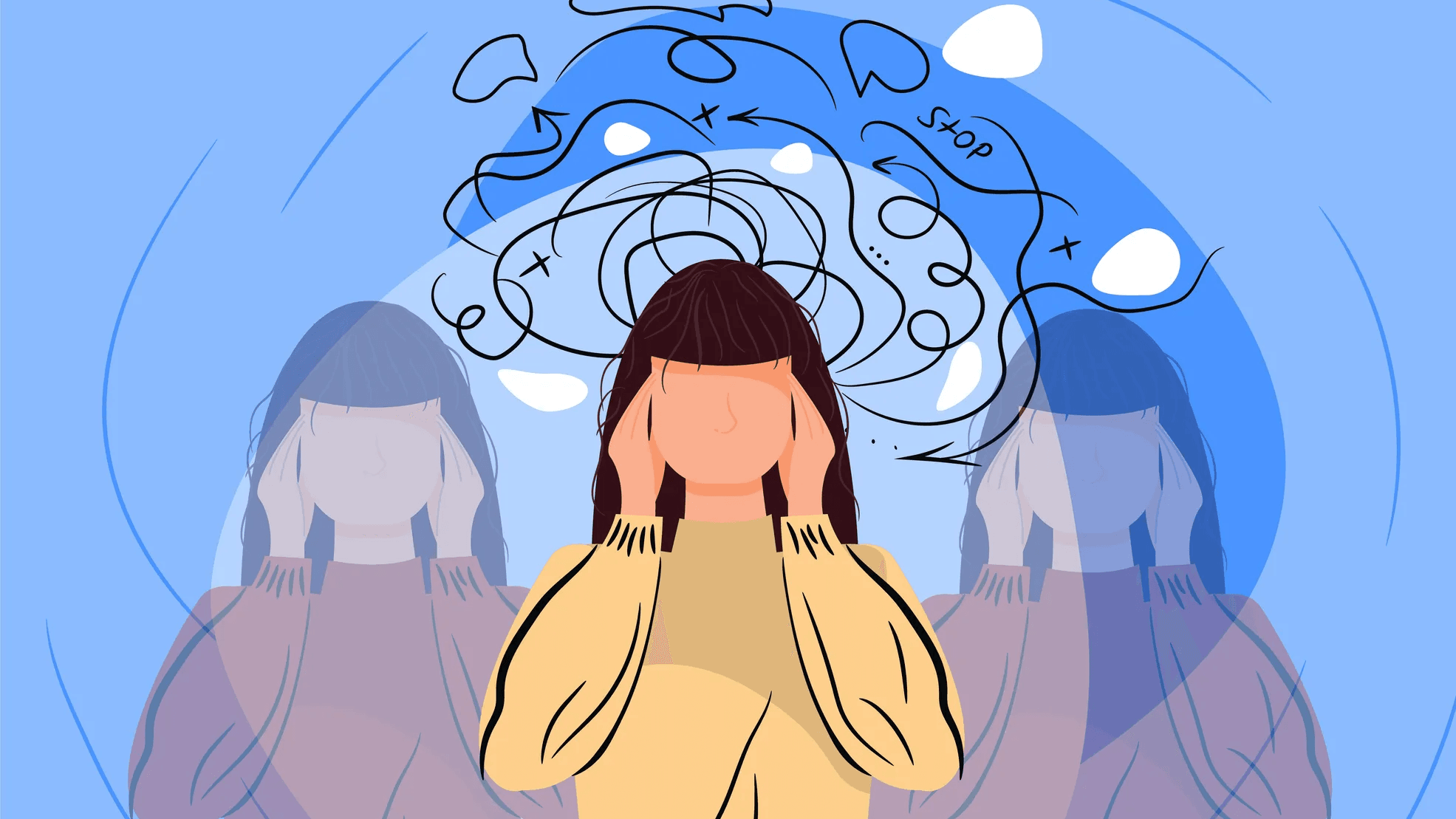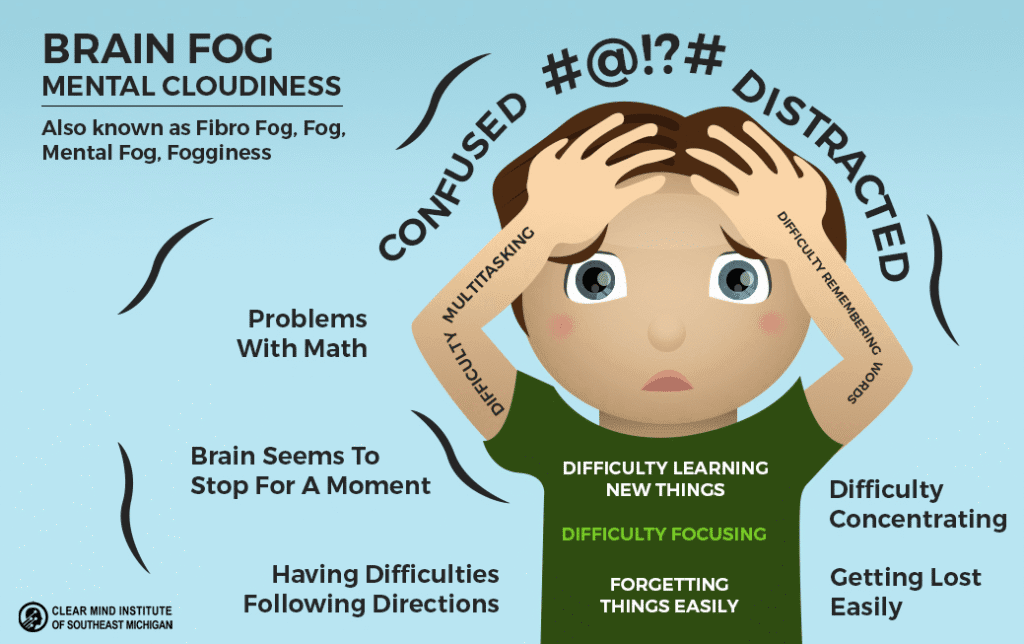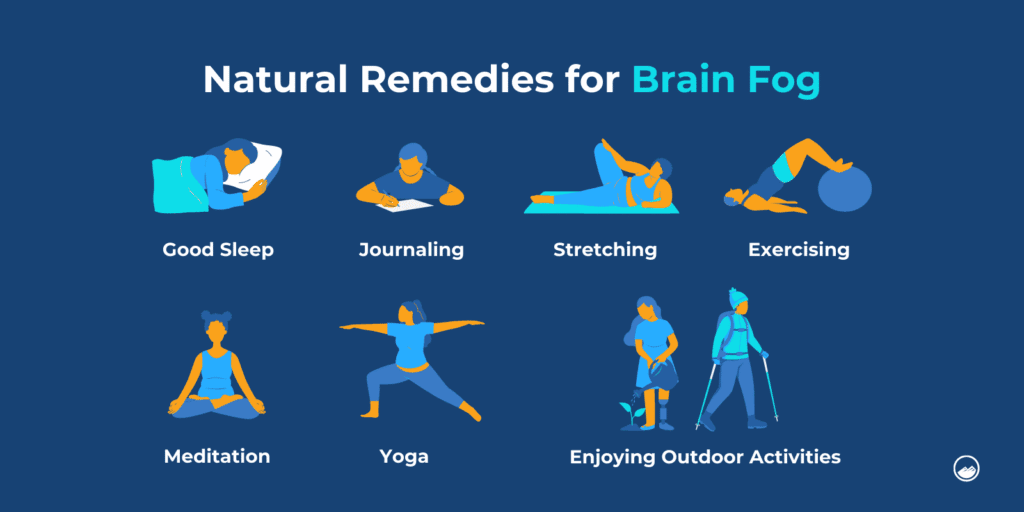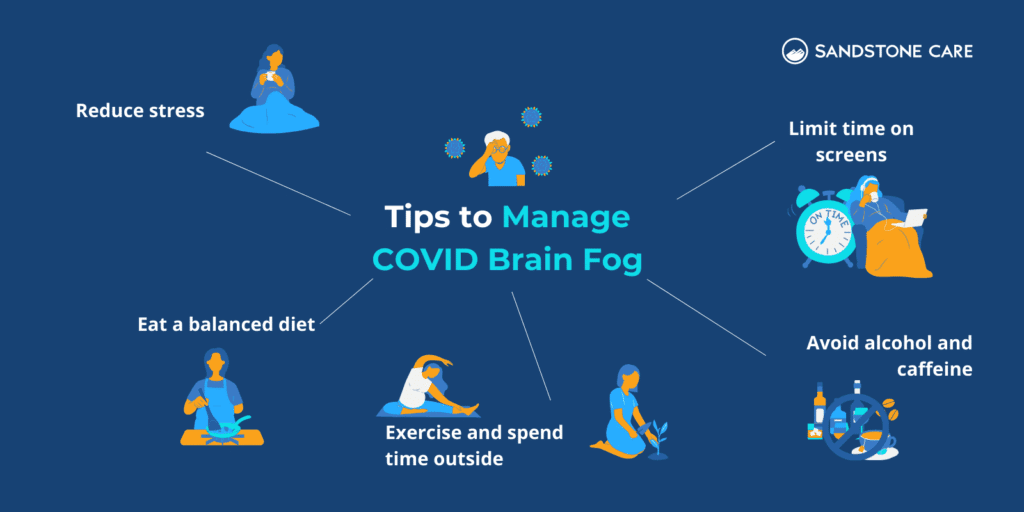What is Brain Fog?
Brain fog is a simplistic term used to refer to a set of symptoms that cumulatively lead to a decline in cognitive abilities. It influences the thinking, remembering and concentration of individuals. Associated with the condition known as clouding of the mind, a fuzzy state of the brain, which is often depicted as a cloud, this issue is characterized by the difficulty to perform routine tasks as well as the ability to have one conversation disrupted in the middle of it.
Table of Contents
What Does Brain Fog Feel Like? | Brain Fog Symptoms

The most common symptoms associated with it are trouble concentrating or focusing, confusion, tiredness, forgetfulness, loss of concentration, loss of train of thoughts, exhaustion of the mind, difficulty trying to remember things, and slow thinking and response to things. These symptoms may vary depending on how annoying they are to how incapacitating they are to performing routine tasks.
It is important to realize that brain fog is not a specific medical diagnosis or disease but one of the symptoms. Rather, it is a reflection of a number of predisposing physical, psychological, and environmental conditions.
The difference is critical to clinical evaluation, with a health practitioner being the one to identify the underlying cause so as to facilitate the right management. As the impact of brain fog may be quite substantial to the everyday performance in life, it can directly influence occupational performance, relationships, psyche and general ability to hold out with daily assignments. People can experience a sense of frustration and feeling trapped like there is a buffering issue in their minds.
Brain Fog Nation Rise of the Post-Vaccination Nation

Brain fog is one of the most frequently experienced cases, and a significant part of the general population reports the occurrence of brain fog. A clinical epidemiological study including more than 25,000 people found out that 28.2 per cent of the participants had brain fog. Such prevalence is rather high and applies to people of all ages with the average age of 35.7 +/- 11.9 yrs which means it is not just the problem of older adults. In addition to that, brain fog is experienced more often by women (Odds Ratio = 1.2, p < 0.001).
Such demographic distribution highlights that brain fog has taken root in younger populations even within their 20s and 30s.
The Rise of a New Disorder

The term brain fog has become prominent, especially in the media and the general conversation, mainly with regard to Long COVID. Although the sources like Google Trends do not offer the specific quantitative data on searches, they indicate high jumps in the volumes of the health-related searches that involves not only the cognitive health attributes, but also such one related to the global events, such as the COVID-19 pandemic.
This increase is an indication of how people have developed interest and concern about mental health and cognitive well-being. At present, these symptoms, which were mainly related with the aging process like forgetfulness and mental fatigue, are being experienced more by people in the younger adult brackets. This change of direction shows that the phenomenon of brain fog has become increasingly more acknowledged as a modern problem with a broad age range.
Rise After Covid-19 Pandemic

The COVID-19 pandemic did not present brain fog as a novel thing since it had been a known symptom even before the current global health crisis. Nevertheless, the pandemic significantly increased its spread and popularity. This can be supported by the fact no matter where one searches, the prevalent statement is that Long COVID is one of the main causes of brain fog.
The pandemic served as a bright booster that raised the status of brain fog as a less-known phenomenon to a widely spoken about, but still mostly unmonitored, popular health issue. This extensive magnitude means that even though the acute stage of the pandemic is receding, long-term cognitive sequelae of the massive infection event will still play a big role in the so-called Brain Fog Nation.
Biologically, females are more prone to have greater activation of the immune system and activity of T-cells, which help in survival terms but also, in turn, can trigger excessive prolonged inflammation that could precondition surge vulnerability to brain fog. Psychosocially, the effects of the depression level that was higher, physical activity level that was lower, and the expanded need to pay more attention to caregiving activities, during the pandemic, may have aggravated brain fog in women.
Multifactorial Aetiology: How Brain Fog Causes
Brain fog is actually a multidimensional issue that has a wide variety of causes, being the result of a mixture of clinical conditions, including lifestyle and occupational activities, as well as environmental exposures. This complex etiology is very important in determining the method of prevention and management.
How Brain Fog Causes?
| Category | Specific Factors |
| Post-Infectious/Medical Conditions | Long COVID-19 (viral persistence, gut microbiome dysregulation, neuroinflammation debate) |
| Autoimmune conditions (Lupus, Multiple Sclerosis, Fibromyalgia) | |
| Hormonal changes (pregnancy, menopause, thyroid diseases) | |
| Medication side effects (chemotherapy, older antihistamines, certain antidepressants) | |
| Diabetes and low blood sugar levels (hypoglycemia) | |
| Vitamin B12 deficiency | |
| Long hospital stays | |
| Lifestyle and Behavioral Determinants | Chronic sleep deprivation/Insomnia |
| High stress levels/Chronic stress (elevated cortisol) | |
| Anxiety and Depression | |
| Burnout | |
| Poor dietary patterns (excessive processed foods, high sugar, refined carbs, unhealthy fats) | |
| Dehydration | |
| Sedentary lifestyle | |
| Drug or alcohol use | |
| Aging (natural slowing of cognitive functions) | |
| Environmental and Digital Stressors | Air pollution (fine particulate matter PM2.5, polycyclic aromatic hydrocarbons PAHs, traffic-related pollution, indoor CO2/VOCs) |
| Excessive screen time/Digital overload (blue light exposure, overstimulation of prefrontal cortex, constant notifications, multitasking, doomscrolling) | |
| Extreme heat or cold exposure |
i. Medical Conditions and Post-Infectious Representation of Agoraphobia

The brain fog is a serious and long-standing sequala of the SARS-CoV-2 infection, which is also known as post-COVID cognitive dysfunction (PCCD). The symptoms may last a few weeks or many months, and an impressive percentage of people are affected, including college students. Research gives evidence that up to 70 percent of patients with persisting symptoms demonstrate organ failure in at least one of five organs four months after the infection. Cognitive deficit is still high among patients of COVID-19 after two years after infection.
It has been suggested that there are a number of mechanisms that have led to the occurrence of Long COVID brain fog. The latest studies indicate that the SARS-CoV-2 virus, which remains in the gut even after the acute infection, is able to make changes in the microbiome of the gut. This change can block the production of serotonin, a very important chemical messenger, and thereby affecting its cognitive ability and causing brain fog condition.
The implication of neuroinflammation in post-COVID brain fog is an area of a rather intricate and unfixed science. Although a few studies have recently connected neuroinflammation with COVID-19, a study conducted by Yale discovered that brain inflammation markers and blood-brain-barrier alterations in the spinal fluid of subjects with Long COVID that had presented with some neuropsychiatric symptoms did not appear to differ significantly.
ii. Determinants of lifestyle and behaviors
Prolonged sleep deprivation and discontinuous sleep are the critical but largely underestimated factors that cause brain fog. Sleep deprivation makes the brain cells ineffective in relaying their messages, this causes lack of concentration, grogginess, moodiness and reduced thinking capacity. Inadequate sleep in the long run is highly correlated with cognitive impairment and neurodegenerative conditions such as Alzheimer disease since it is associated with the pooling of amyloid-beta plaques, augmented brain inflammation, imbalances of neurotransmitters.
iii. Environmental and Digital Stressors
The brain effects of air pollution Air pollution is increasingly implicated in brain related disorders leading to cognitive decline and what is also known as brain fog or foggy brain, mainly in children and the elderly. Of special interest are fine particulate matter (PM2.5) and polycyclic aromatic hydrocarbons (PAHs). The microparticles may be transported to the brain through olfactory nerves or blood vessels where they cause neuroinflammation and oxidative stress or releases chemicals that can cause damage to the brain cells.
Exposure to levels of air pollution above the safety limits in the short term shows links to lower output of workers and short attention spans in children. The adverse effects of longer-term (up to three-year) exposure are much more apparent in the field of cognitive functions. There is also indoor air pollution adverse effect on performance and productivity through high levels of carbon dioxide (CO2) and volatile organic compounds (VOCs).
Brain Fog and its Long-term Effects
i. Mental and Mental Health Burden

Brain fog has a direct negative impact on other important skills and abilities such as memory, concentration, attention, and executive functions. This shows in the form of inability to focus, recollect details, follow discussions, fill forms and do mental calculations, etc. In teenagers, it may manifest in impairment in concentration, memory, or thoughts become overwhelmingly exhausting and leads to difficulties in performing menial tasks.
Having brain fuzz is something that is usually characterized as annoyance and tiring. It may create the sense of being trapped, overly stressed and even seen by others as less smart and less such a good talker. Increased anxiety, depression, irritability and mood swings are also common signs of brain fog. The need to think clearly when the brain is not functioning in a clear state, is a constant problem that can and will add more stress to already stressed situations, creating a pile on situation.
The study reveals that brain fog includes some considerable impacts of frustration, anxiety and depression. On the same note, there are certain psychological conditions which have been diagnosed as the contributing factors to brain fog as well.
ii. Social, Economic and Productivity Costs
Brain fog is a major performance inhibitor which causes decreased productivity, likelihoods to make mistakes and ease off often in the need to re-halve. This may cause failure to achieve the deadlines, reduced production, poor quality of work and inability to grow in terms of career since it is hard to learn new things, or accept some challenging projects. Research indicates that employees with poor diet or unhealthy eating, which is considered to be a great contributor to brain fog, have a 66 percent increased risk of low productivity than the rest of the workers with adequate diets.
Mental exhaustion predisposes people to hasty and illogical spending decisions. When our brain is not functioning at its best ability, it becomes more difficult to break down the information, risks, and planning. This may cause purchase impulse, wrong investment decisions, more debt, and delay of financial essential actions. This brain fog tax is a clandestine expense that can transform into big economic consequences on individuals and levels and national economic expense.
To give an example, a software engineer who charges an hourly rate of 100 dollars per hour will often work 8 hours on coding in a day. In the case of brain fog, it might decrease to 6 hours and it leads to a loss of 200 dollars a day which translates to 4,000 dollars monthly. Equally, a person is tired after a hard day and he can soon proceed to get take out that costs 50 dollars instead of making a healthy meal at 15 dollars, a slight convenience that adds up over time.
How to Get Rid of Brain Fog?
i. Lifestyle and Behavioral Intervention

Sleep hygiene is essential in ensuring good cognitive processes, the formation of memories and the natural processes of toxin clearing in the brain. It is crucial to create some sort of routine regarding sleep: allow yourself sufficient rest (7-8 hours is suggested in a day), have a routing ceremony before going to sleep. The main mechanism of controlling the natural circadian rhythm of the body is to limit the use of bright light and electronic devices before going to bed.
iii. The Dietary Treatments to Use on the Brain

The brain requires a diet that is composed of whole unprocessed foods. This diet also goes very much according to the principles of the Mediterranean Diet, which is also always appraised as extremely useful to both the brain and the body. Important ones are antioxidants and flavonoids present in high amounts in berries, dark chocolate, leafy vegetables, and citrus fruits and they preserve the brain cells by counteracting the blightful free radicals and preventing inflammation.
Omega-3 fatty acids have been found to result in enhanced learning and recall without any brain cells being built or fixed up, that is why they are important in the construction and mending of brain cells. Sources of the rich ones are fatty fish such as salmon, tuna, and mackerel and seeds and nuts. Folate and B vitamins help to produce energy and your body to make neurotransmitters that are present in foods, such as eggs, leafy green vegetables, and whole grains. Beneficial fats like stomach avocado and olive oil give significant nutrients to the head shape and operation.
iv. Public Health and Clinical Strategies
In the case when brain fog is chronic or causing tremendous inconveniences, it is recommended to seek specialized medical advice. A health care professional may assist in unravelling the cause with medical and psychological history, symptomatology, laboratory examination (vitamin deficiencies, hormonal imbalances), and psychiatric examination. Telehealth platforms will also offer an accessible alternative to providing specialized memory and thinking care with fast booking times with care navigators and neurologists, large and multidisciplinary care teams.
In treating the certain symptoms and coping approaches, therapeutic objects can employ cognitive rehabilitation and cognitive behavioral therapy (CBT). In the case that brain fog is caused by a certain deficiency, e.g. vitamin B12, then supplements can be prescribed. In some cases, medications can be implemented, including antidepressants or nonsteroidal anti-inflammatory drugs (NSAIDs) to overcome certain symptoms as long as the change of lifestyle is not effective enough in alleviating them.
Here’s What You Should Remember
A feeling of brain haze is a high-volume association of cognitive symptoms that have evolved to become a critical, however under-identified, national health epidemic. Its increasing commonality especially with a boost provided during COVID-19 pandemic highlights a significant threat to cognitive well-being in society. The multifaceted causes of the condition are overshadowed by the factors of post-infectious sequelae and medical issues, as well as the universal lifestyle, environmental, and digital stressors.
Lack of an official diagnosis and any trustworthy measurable indicators creates the situation when brain fog is kind of an invisible illness, which causes frustrations in the patient along with a delayed response and underestimation of the actual effects. This absence of tracking is also reflected in its high socio-economic cost as the loss of productivity and undermined decision-making is a cost that goes uncalculated on both the individuals and the economy at large.
References
- Jindal, Sneha & Bodnar, Susan. (2025). ‘Brain Fog’: Exploring Associations with Stress, Connectedness to Nature, and Mindfulness. 10.31234/osf.io/4tas7_v1.
- https://my.clevelandclinic.org/health/symptoms/brain-fog
- Office for National Statistics. Prevalence of ongoing symptoms following coronavirus (COVID-19) infection in the UK: 5 January 2023. Retrieved from, https://www.ons.gov.uk/peoplepopulationandcommunity/healthandsocialcare/conditionsanddiseases
- Carfì, A., Bernabei, R. & Landi, F. Persistent symptoms in patients after acute COVID-19. JAMA, 324, 10.1001/jama.2020.12603 (2020).
[DOI] [PMC free article] [PubMed] - Rao, S. et al. Clinical features and burden of postacute sequelae of SARS-CoV-2 infection in children and adolescents. JAMA Pediatr.176, 10.1001/jamapediatrics.2022.2800 (2022).
[DOI] [PMC free article] [PubMed] - Eysenbach, G. Infodemiology and Infoveillance: framework for an emerging set of public health informatics methods to analyze search, communication and publication behavior on the internet. J. Med. Internet Res.11, 10.2196/jmir.1157 (2009).
[DOI] [PMC free article] [PubMed] - Rumage, J. 16 Top Search Engines to Try. builtin. Retrieved from https://builtin.com/consumer-tech/search-engines-list
- Hsu, N. J., Hung, H. L. & Chang, Y. M. Subset selection for vector autoregressive processes using LASSO. Comput. Stat. Data Anal.52, 3645–3657 (2008).
[Google Scholar] - Crook H., Raza S., Nowell J., Young M., Edison P. Long covid-mechanisms, risk factors, and management. BMJ. 2021;374:n1648. doi: 10.1136/bmj.n1648.
[DOI] [PubMed] [Google Scholar] - Thakur K.T., Miller E.H., Glendinning M.D., et al. COVID-19 neuropathology at Columbia University Irving Medical Center/New York Presbyterian Hospital. Brain. 2021;144(9):2696–2708. doi: 10.1093/brain/awab148.
[DOI] [PMC free article] [PubMed] [Google Scholar] - Petersen E.L., Gossling A., Adam G., et al. Multi-organ assessment in mainly non-hospitalized individuals after SARS-CoV-2 infection: the Hamburg City Health Study COVID programme. Eur Heart J. 2022;43(11):1124–1137. doi: 10.1093/eurheartj/ehab914.
[DOI] [PMC free article] [PubMed] [Google Scholar] - Ngandu T., Lehtisalo J., Solomon A., et al. A 2 year multidomain intervention of diet, exercise, cognitive training, and vascular risk monitoring versus control to prevent cognitive decline in at-risk elderly people (FINGER): a randomised controlled trial. Lancet. 2015;385(9984):2255–2263. doi: 10.1016/S0140-6736(15)60461-5.
[DOI] [PubMed] [Google Scholar] - Jia J.P., Gong M. [“Cognitive unit” is a diagnosis and treatment pattern suitable for the clinical practice of cognitive disorders in China] Zhonghua Yi Xue Za Zhi. 2020;100(9):645–647. doi: 10.3760/cma.j.issn.0376-2491.2020.09.002.
[DOI] [PubMed] [Google Scholar] - https://www.apa.org/monitor/2012/07-08/smog
- Graham EL, Clark JR, Orban ZS, Lim PH, Szymanski AL, Taylor C, DiBiase RM, Jia DT, Balabanov R, Ho SU, Batra A, Liotta EM, Koralnik IJ. Persistent neurologic symptoms and cognitive dysfunction in non-hospitalized Covid-19 “long haulers”. Ann Clin Transl Neurol. 2021 May;8(5):1073-1085. doi: 10.1002/acn3.51350. Epub 2021 Mar 30. PMID: 33755344; PMCID: PMC8108421.

